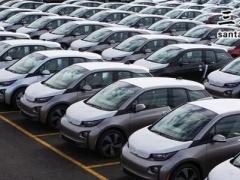印度的增速超过了中国,但竞赛的方向或许错了 [印度媒体]
我们就承认吧,中国对于印度来说就是那个“别人家的孩子”。不管你读了多少书,祈求了多少奇迹,隔壁老王家还是有那么一个闪闪发光让你怎么也追不上的孩子。哪怕是近期印度的GDP增速已经可以和中国相提并论了,那也是中国正在大范围减速,而印度蹿了上去罢了。
India has overtakenChina’s growth, but may have signed up for the wrong marathon event
印度的增速超过了中国,但竞赛的方向或许错了
作者:AurodeepNandi
Let’s admit it. Chinais the country-equivalent of ‘Sharmaji ka beta’ for India. Regardless of howmuch you studied, or miracles you prayed for, there was always that prodigiouschild of the neighbourhood Mr Sharma who happened to be a shining example ofthe student you could never become. And while it is true that recently India’sGDP growth seems somewhat comparable to China’s, the statistical high jumpcomes on the back of a broad-based slowdown in the Chinese economy.
我们就承认吧,中国对于印度来说就是那个“别人家的孩子”。不管你读了多少书,祈求了多少奇迹,隔壁老王家还是有那么一个闪闪发光让你怎么也追不上的孩子。哪怕是近期印度的GDP增速已经可以和中国相提并论了,那也是中国正在大范围减速,而印度蹿了上去罢了。
Only a few years ago,when the Chinese economy was growing at full steam, it was hauling with itcommodity prices and the fortunes of dozens of economies around the globe.While China has become a global manufacturing powerhouse, the share ofmanufacturing in India’s GDP has remained static at 15-17 per cent levels forthe last 40 years.
几年前,当中国的经济还在全速井喷的时候,中国商品的价格牵动着几十个经济体的起伏。当中国成为全球制造业的发电厂时,印度制造业在国内的GDP份额还是岿然不动,40年来一直维持15-17%的水准。
Before trying this athome…
在家里尝试这个之前……
China has not justemerged as the world’s factory, but has changed the definition of whatfactories around the world make. Globally, manufacturing no longer happens inone country or workshop, but small bits of everything get added by companies indifferent countries, in effect, creating a mega global assembly line: globalvalue chains.
中国不只是成为了世界工厂而已,它还改变了“工厂能做什么”的定义。制造不再是一国一车间的事,而是散落在不同国家的无数个单位所连接成的巨型全球装配线,也就是全球价值链(global value chains)。
Countries that manageto align their export strategy such that they sit snugly within such chains aregenerally more successful in manufacturing in the new globalised world. 60 percent of China’s exports link into existing global value chains. Only 36 percent of Indian exports manage this feat. Indian manufacturing, naturally, isfar from capturing the global imagination the way China has managed to do.
那些成功将出口策略与价值链相匹配,取得优势地位的国家,在全球化的制造业中自然越来越成功。中国有60%的出口都已连入了全球价值链,而印度只有36%的出口做到了这一点,于是印度的制造业自然也不能像中国那样吸纳全球化的想象力。
The common narrativehas been that China has beaten India in its government’s ability toaggressively invest in infrastructure, encourage more foreign directinvestment, build city-like special economic zones, increase access to creditand promote trade with a vengeance.
一般认为,中国是通过政府强有力的基础设施投资、鼓励外商直接投资、建造城市规模经济特区、增加信贷渠道、大力刺激贸易等方法打败印度的。
Most of these, Indiahasn’t perfected. Thus the common notion that India needs to piously build aglitzy skyline of reforms and initiate big-ticket investment projects to getanywhere close to the economic heft of China.
上述这些印度做的还远非完善,因此一般观点认为印度就该老老实实造大楼,翻新城市,进行大规模投资项目,好在经济体量上能追赶中国。
China’s actualeconomic liberalisation didn’t start with constructing grand cities orproducing everything from ink pens to iPhones. It began with reforming the farmsector and, in the process, improving human development indicators like health,nutrition and education.
可实际上,中国真正的经济开放并非始于建造宏伟的城市,也不是一上来就能把钢笔到iPhone都造了。中国的经济改革始于田间,并在此过程中,逐渐提升健康、营养和教育等人类发展指数。
When China decided toreform in the 1980s, it realised that 80 per cent of its citizens wereagricultural peasants. Widespread land and agriculture reforms were firstintroduced to unlock prosperity in the farm and, consequently, in the non-farmsector. China’s agricultural productivity saw a dramatic improvement as thesereforms continued. Rural-based private enterprises were strongly incentivisedby the government that, in turn, had a multiplier effect on employment.
20世纪80年代,当中国决意改革的时候,其80%的国民还是农民。广大的地域加上农业改革首先迎来了农业的繁荣,继而促进了非农业地区的发展。中国的农业生产力实现了惊人的进步,而改革继续推进,乡间的私人企业也得到了政府的大力促进,反过来创造了指数级的岗位。
In the case of India,50 per cent of the workforce is involved in agriculture. However, India’sflirtation with agrarian reforms ended with the Green Revolution severaldecades back. Since then, India’s strategy — or, rather, the lack of strategy —has been to prop up the sector with subsidies and minimum support prices.
反观印度,50%的劳动力仍束缚在农业上。然而印度的土地改革经过多次反复,最终在几十年前就随着“环保革命”而终止了。从那以后,印度的发展策略——或者说,没有策略——就变成了靠津贴和极低的维持性价格来保住农业地块。
Aggressive reform offarm infrastructure, land leasing, productivity and freeing up the market fromthe clutches of self-serving traders remain a pipe dream in India. To give asense of how unreformed markets in India are, seasoned middlemen in Delhi’sAzadpur mandi, Asia’s largest wholesale fruit and vegetable market, are known tonegotiate by touching each other’s hands under a handkerchief and communicatingwith gestures. So much for transparent pricing for farmers.
大踏步的农业基础设施换代,土地租赁,生产率的提升,将市场从自给自足的局面中解放出来……这一切对于印度来说还是白日梦。想知道没经过改革的印度市场是什么样,只要看一看亚洲最大的水果蔬菜批发市场,德里Azadpur mandi里头的那些经销商们:这群人出名的一点就是,他们现在还靠在手帕下面握手时划拉出各种手势来讨论价格。那农民所面临的价格透明度情况也就可想而知了。
To that extent, it isa welcome move that finance minister Arun Jaitley in his Budget speech unveiledambitious plans for the government’s new electronic national agriculture market(e-NAM) that is intended to get buyers and sellers on a platform withoutgeographical boundaries.
在这种情形下,财长阿伦.贾特利(ArunJaitley)在他的预算讲话中所提到的,雄心勃勃的全国电子农业市场计划无疑是可喜的一步。此举意在给予买方和卖方一个超越地理限制的平台。
The other ace upChina’s sleeve has been human development. India ranks 130 out of 188 countriesin the Human Development Index, even lower than war-torn parts of the worldlike Iraq and Palestine. China ranks 50 notches higher at 90, and is in the top10 in Asia. China spends 2 per cent of its GDP on health, double of what Indiamanages to do. Deep caste and gender inequality here further exacerbate health,education and nutritional outcomes.
令中国能够胜出的其实还有一点没有说到:那就是它的人类发展水平。按照人类发展指数,印度在188个国家里才排名130,甚至比饱受战火蹂躏的伊拉克和巴勒斯坦还差。中国则比印度高了50名,排在第90位(原文如此),位列亚洲的前十名。中国将2%的GDP用于健康事业,两倍于印度所达到的程度。根深蒂固的种姓和性别不平等更加剧了健康、教育和营养方面的问题。
China’sfemale-to-male labour force ratio is almost double that of India’s. Over 96 percent of China’s adults are literate compared to around 71 per cent for India.
中国的女性和男性劳工比是印度的将近两倍。中国识字的成年人超过96%,而印度只有大概71%。
Half a millionstillbirths happen in India every year, the highest in the world. Over 600million Indians defecate in the open.
印度每年的死产案例有50万,位居世界第一。超过6亿人在露天排便。
So, while it’simpressive that India has recently overtaken China’s growth, we may have signedup for the wrong marathon event. As Sharmaji ka beta would have said withirritating self-efficacy when pestered about how he managed to seamlessly aceexam after exam: don’t study thinking about the marks. First get the basicsright.
因而,印度的近期增速超过了中国固然可喜,但我们竞赛的方向或许错了。就如同“别人家的孩子”被缠着问为啥场场考试都得高分,于是带着令人恼火的志得意满态度所说的那样:别想分数,先打好基础。
版权声明
我们致力于传递世界各地老百姓最真实、最直接、最详尽的对中国的看法
【版权与免责声明】如发现内容存在版权问题,烦请提供相关信息发邮件,
我们将及时沟通与处理。本站内容除非来源注明五毛网,否则均为网友转载,涉及言论、版权与本站无关。
本文仅代表作者观点,不代表本站立场。
本文来自网络,如有侵权及时联系本网站。
图文文章RECOMMEND
热门文章HOT NEWS
-
1
चाइना में रेडी और ठेले Local shops in china || L...
- 2
- 3
- 4
- 5
- 6
- 7
- 8
- 9
- 10
推荐文章HOT NEWS
-
1
चाइना में रेडी और ठेले Local shops in china || L...
- 2
- 3
- 4
- 5
- 6
- 7
- 8
- 9
- 10











